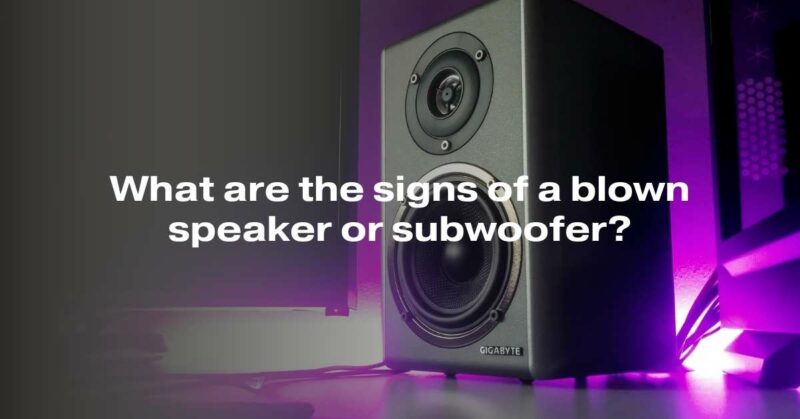Speakers and subwoofers are essential components of audio systems, delivering rich sound experiences in various settings, from home theaters to car audio systems. However, like any electronic device, they can experience wear and tear over time, and one common issue that users encounter is a blown speaker or subwoofer. Knowing the signs of a blown speaker or subwoofer is crucial for diagnosing and addressing the problem promptly to avoid further damage and ensure the best audio quality. In this comprehensive article, we will explore the telltale signs that your speaker or subwoofer might be damaged and what steps you can take to address the issue.
- Distorted Sound
One of the most common and noticeable signs of a blown speaker or subwoofer is distorted sound. When a speaker’s components are damaged, it can no longer reproduce audio accurately, resulting in distortion. This distortion can manifest as crackling, popping, buzzing, or rattling noises, especially at higher volumes or when playing bass-heavy music. If you notice a significant decline in audio quality and distorted sound, it may be a sign of a blown speaker.
- Lack of Bass Response
Subwoofers are responsible for delivering deep, low-frequency bass sounds in audio systems. If your subwoofer is blown, you might notice a lack of bass response or a significant reduction in the intensity of the low-frequency notes. Instead of producing the rich and powerful bass you’re used to, a blown subwoofer may produce weak, muddy, or distorted bass, diminishing the overall audio experience.
- Unusual Vibrations
A functioning speaker or subwoofer should produce sound without any excessive vibrations or rattling. When a speaker is blown, the damaged components can create vibrations within the speaker enclosure, resulting in an unsettling rattling or buzzing noise. You might even feel these vibrations if you touch the speaker or subwoofer cabinet while it’s playing. Unusual vibrations are a clear indication that something is wrong with your speaker.
- Overheating
Overheating is another sign that your speaker or subwoofer may be damaged. Excessive heat can cause the voice coil or other internal components to fail. If you notice your speaker or subwoofer becoming unusually hot during operation, it’s a warning sign that there might be an issue. Continued use in this state can exacerbate the damage, so it’s crucial to address overheating promptly.
- No Sound Output
The most obvious sign of a blown speaker or subwoofer is the absence of sound output altogether. If your speaker or subwoofer is no longer producing any audio, it’s a strong indication that a critical component, such as the voice coil, has failed. In such cases, there may be a complete loss of function in the affected driver, rendering it useless until repairs or replacement are performed.
- Smoky or Burnt Odor
In severe cases of speaker or subwoofer damage, you may notice a smoky or burnt odor. This smell can indicate that the voice coil or other internal components have overheated to the point of damage. It’s essential to immediately power off the audio system if you detect this odor to prevent further damage or potential fire hazards.
- Visual Inspection
A visual inspection can also reveal signs of speaker or subwoofer damage. Look for visible damage to the speaker cone, surround, or the speaker’s frame. If you see any tears, punctures, or deformities in these components, it’s a clear indication of damage. Additionally, inspect the connections and terminals for loose wires or signs of overheating, such as discoloration or melting.
Conclusion
Recognizing the signs of a blown speaker or subwoofer is vital for maintaining the quality of your audio system and preventing further damage. If you experience distorted sound, a lack of bass response, unusual vibrations, overheating, no sound output, or detect a smoky or burnt odor, it’s time to investigate and address the issue. A visual inspection can also provide valuable clues.
Depending on the severity of the damage, you may need to consider repairing or replacing the affected speaker or subwoofer. Regular maintenance, proper usage, and avoiding pushing your audio system to its limits can help extend the lifespan of your speakers and subwoofers, ensuring that you continue to enjoy high-quality sound for years to come.


